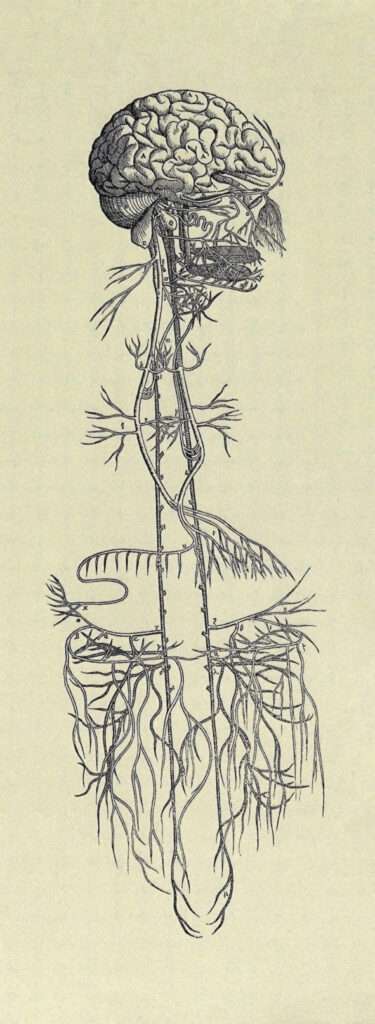
Polyvagal Theory – developed by Dr. Stephen Porges– is a neurophysiological framework for observing human experiences and behaviour in the context of adaptive physiologies that have evolved over hundreds of thousands of years. Polyvagal Theory is a non-pathologizing lens that situates humans in kinship with other species and each other. Polyvagal theory is flexible and inclusive, and its use makes it possible to observe and bring greater compassion to ourselves and each other, across differences. As such, Polyvagal theory has provided helpful heuristics for several schools of body psychotherapy, and approaches to trauma resolution. It has changed the landscape of psychotherapy, influencing the ways we look at psychological processes and emotional embodiment.

According to Polyvagal Theory
Similar to mammalian kin and distinct from our reptilian ancestors, humans have three possible systems through which we respond to our environment. These three states are influenced by our perception of threat. The most advanced state evolved when mammals adapted towards collaboration so that offspring were more likely to survive. This social engagement system, or Ventral Vagal complex, has nuanced embodied cognitive capacities, including curiosity, creativity, and connection. However, when threat is perceived to be great, or pervasive, and when the social engagement system fails to provide a sense of safety, two phylogenetically older systems are recruited in the order of most to least complex. These older systems are the mobilizing sympathetic (fight/flight) system, and the freeze/immobility/collapse response (Dorsal Vagal Complex) which is the protective system of last resort. These three systems are not mutually exclusive, but one of the three is always dominant.
Porges coined the term “neuroception” to describe how we sense safety and threat through our bodies. The neuroception of threat is not cognitive. When the nervous system senses threat, the more advanced social engagement system is dominated by unconscious reflexes to self-protect which are enacted in the body. These may show up as repetitive patterns, appearing, for example, as aggression, impotent rage, obsessive distraction, and addiction. These and even older, shut-down patterns that evolved long ago, render bodies disconnected from themselves and each other. When freeze/immobility is dominant, the social engagement system either does not function optimally or is offline. Disorganized thinking is a feature of this physiology, including non-rational negative thought spirals and catastrophizing. Here, bodies may feel frozen into complacency or paralyzed by shame. This shields the self from disturbing truths, and has been protective for a time. Until it isn’t.
In therapy, neuro-affective maps of the threat-response cycle based in polyvagal theory support movements towards the renegotiation of agency and connection. Polyvagal Theory deemphasizes individual pathology, and points to strategies for deepening experience in connection with others.
Through the lens of polyvagal theory, and using an experiential somatic approach, it is possible to observe, understand, and renegotiate protective responses. In the work of Somatic Experiencing™, for example, people learn to track sensations and movements, bearing witness, and engaging tissue, posture, and behaviour. When people learn to witness their own activation, staying present at the edge of difficult and ambiguous tensions, feelings and uncomfortable sensations, a little at a time, without becoming overwhelmed and shutting down, tissues are able to complete defensive, self-protective gestures. This allows for change in the affective and cognitive loops that may otherwise become trapped in a disorganized state, or repetitive cycle
For an excellent graphic depicting the neuroception of threat according to Polyvagal Theory https://www.swtraumatraining.com/_files/ugd/e051b5_96779d0200ea484e9b60d2fd5b192ff4.pdf
References
Payne, P., Levine, P. A., & Crane-Godreau, M. A. (2015). Somatic experiencing: using interoception and proprioception as core elements of trauma therapy. Frontiers in Psychology, 6. https://doi.org/10.3389/fpsyg.2015.00093
Porges, S. W. (1995). Orienting in a defensive world: mammalian modifications of our evolutionary heritage. A Polyvagal Theory. Psychophysiology, 32(4), 301–318.
––––––––––– (2001). The polyvagal theory: phylogenetic substrates of a social nervous system. International Journal of Psychophysiology: Official Journal of the International Organization of Psychophysiology, 42(2), 123–146.
–––––––––––(2009). The polyvagal theory: New insights into adaptive reactions of the autonomic nervous system. Cleveland Clinic Journal of Medicine, 76(Suppl 2), S86–S90.
–––––––––––(2011). The polyvagal theory: neurophysiological foundations of emotions, attachment, communication, and self-regulation. New York: W.W. Norton. Porges, S. W., & Furman, S. A. (2011). The Early Development of the Autonomic Nervous System Provides a Neural Platform for Social Behavior: A Polyvagal Perspective. Infant and Child Development, 20(1), 106–118
